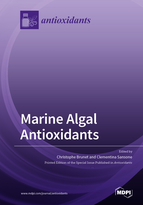Marine Algal Antioxidants
A special issue of Antioxidants (ISSN 2076-3921). This special issue belongs to the section "Natural and Synthetic Antioxidants".
Deadline for manuscript submissions: closed (15 October 2019) | Viewed by 62387
Special Issue Editors
Interests: photosynthesis; microalgae; bioactive molecules; biotechnology
Special Issues, Collections and Topics in MDPI journals
Interests: marine biotechnology; drug discovery; cell biology; pharmaceuticals; nutraceuticals and cosmetics
Special Issues, Collections and Topics in MDPI journals
Special Issue Information
Dear colleagues,
It is a pleasure for us to invite you to contribute to this Special Issue of Antioxidants by submitting original research papers or review articles focusing on Marine Algal Antioxidants.
The aim of this Special Issue is to present recent investigations into marine algal antioxidants and antioxidant networks functioning in algae.
The topics covered in this Special Issue will spawn from the diversity of antioxidant molecules in marine algae to their ecological role in marine ecosystems and their potential interest for biotechnological applications. Since the huge ecological forcing difference between marine and terrestrial systems, related for instance to the diversity of carotenoids reported in the marine algal world, compared to terrestrial plants, it is expected that antioxidant molecules (diversity, production, role) in marine algae also present peculiar properties.
This Special Issue aims to present data and the state-of-art on the way to increase antioxidant production for their exploitation in different fields, such as nutraceutics or cosmetics. On this topic, the plus-value of algal biodiversity for antioxidant molecule production will be also questioned.
There is no way to improve the sustainable and efficient production of bioactive molecules from photosynthetic organisms without an ecological knowledge of both the targeted organisms and family of molecules. The latter enters into finely-tuned mechanisms of defence, protection and/or repair acting in a balanced syntony with the photosynthetic and metabolism activity, modulated by adaptation, acclimation or regulation features operated by the organisms.
While a plethora of antioxidant molecules produced by higher plants are known and have been well-documented by many reports, little is known about the bioactive molecules from marine algae, with the exception of the carotenoids pool. Other families of antioxidant molecules are found in microalgae, such as phenolic compounds (e.g., flavonoids), lipophilic molecules synthesized by photosynthetic organisms, such as ascorbic acid (vitamin c) and tocopherols (vitamin E), and glutathione and phycobiliproteins present in few algal groups. While it is reported that these families of molecules with potential antioxidant roles are present in microalgae, little is known about their diversity, role or activity.
We look forward to receiving many contributions and stimulating a productive discussion on this exciting thematic of marine algal antioxidants.
Best regards,
Dr. Christophe Brunet
Dr. Clementina Sansone
Guest Editors
Manuscript Submission Information
Manuscripts should be submitted online at www.mdpi.com by registering and logging in to this website. Once you are registered, click here to go to the submission form. Manuscripts can be submitted until the deadline. All submissions that pass pre-check are peer-reviewed. Accepted papers will be published continuously in the journal (as soon as accepted) and will be listed together on the special issue website. Research articles, review articles as well as short communications are invited. For planned papers, a title and short abstract (about 100 words) can be sent to the Editorial Office for announcement on this website.
Submitted manuscripts should not have been published previously, nor be under consideration for publication elsewhere (except conference proceedings papers). All manuscripts are thoroughly refereed through a single-blind peer-review process. A guide for authors and other relevant information for submission of manuscripts is available on the Instructions for Authors page. Antioxidants is an international peer-reviewed open access monthly journal published by MDPI.
Please visit the Instructions for Authors page before submitting a manuscript. The Article Processing Charge (APC) for publication in this open access journal is 2900 CHF (Swiss Francs). Submitted papers should be well formatted and use good English. Authors may use MDPI's English editing service prior to publication or during author revisions.
Keywords
- Antioxidant biodiversity
- Vitamins
- Flavonoids
- Phycobiliproteins
- Phenolic compounds
- Carotenoids
- Antioxidant network and protective mechanisms in microalgae
- Sustainable production of microalgal antioxidant molecules
- Analytical methodology: Antioxidant molecules determination
- Analytical methodology: Antioxidant activity determination
- Antioxidant activity in vitro
- Molecular pathways activated by microalgal antioxidants








